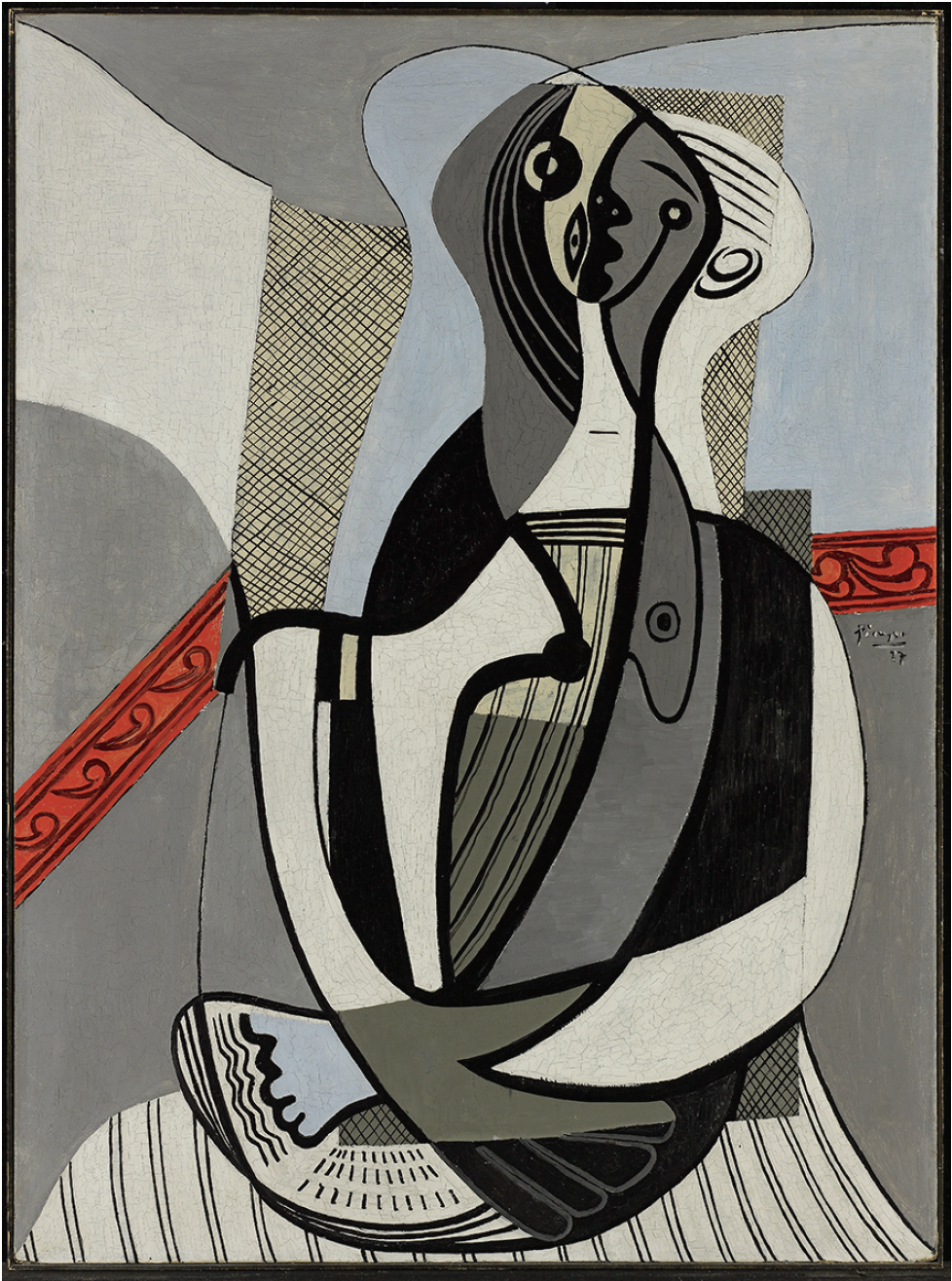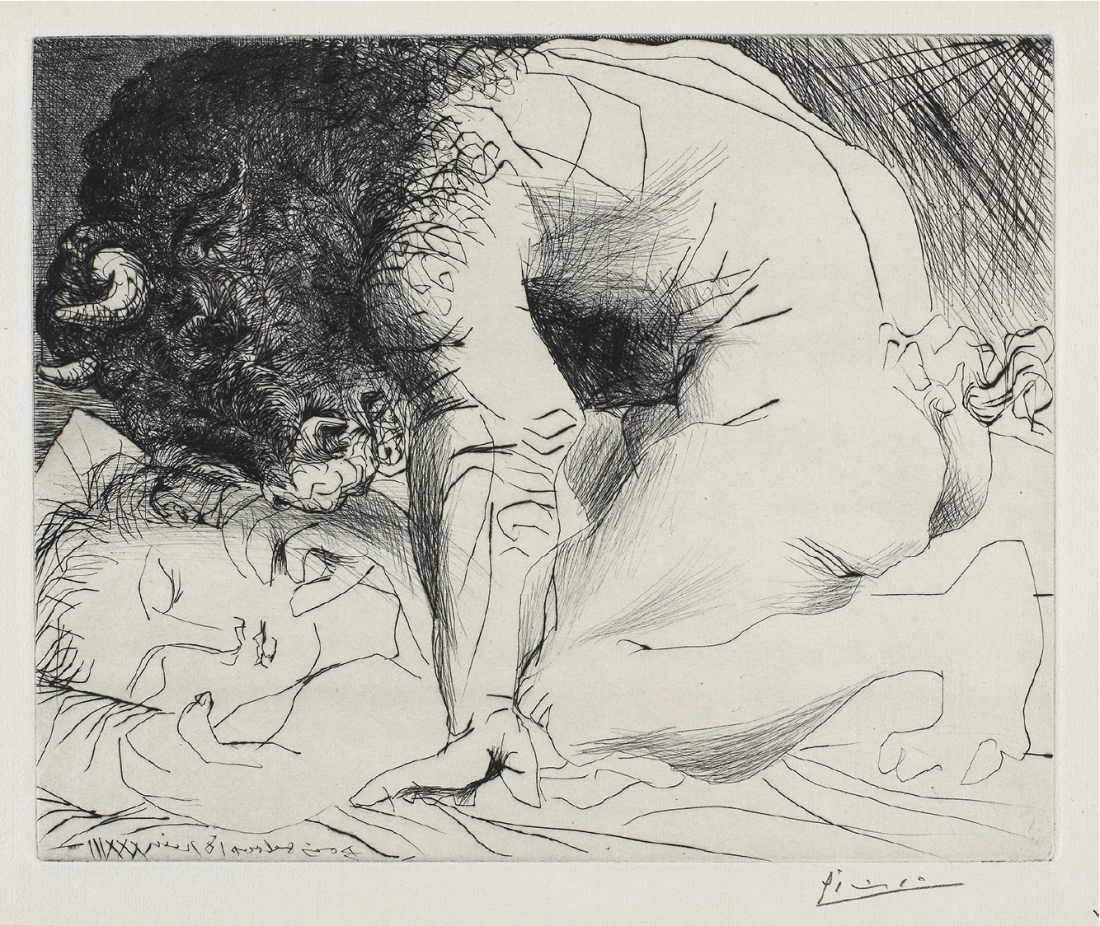“Picasso in Canada” and “Picasso: Man and Beast”
Two related shows at the Winnipeg Art Gallery (WAG) raise a tricky 21st-century question: How do we look at Picasso now?
Citing his seemingly unassailable influence, versatility and creative output, the conventional approach casts Picasso as the defining artist of the 20th century. The notion of genius floats around his name, a heavy designation that wraps the man and his work in a modernist mystique. More recently, revisionist histories have focused on Picasso’s life, revealing him as a bully, a narcissist, a wealthy cheapskate, a rapacious lover and neglectful father, and reinforcing another kind of myth—the artist as creator and destroyer.
Attempting to balance these two opposing approaches, this ambitious project combines the WAG-generated “Picasso in Canada” with “Man and Beast,” a rare full exhibition of Picasso’s “Vollard Suite” of prints organized by the National Gallery of Canada. While clearly relying on Picasso’s big-name branding and towering reputation to bring in the crowds, the work is displayed and contextualized in a way that draws out the complex connections between Picasso’s life and art, and foregrounds his tortured (and often torturing) relationships with women.
The entrance to the exhibition is flanked by a blown-up Arnold Newman photograph of the artist in his studio, which plays up his barrel-chested posture and pugnacious gaze. Picasso is one of the few men who can look combative while wearing carpet slippers.

Pablo Picasso, Femme assise, 1927, oil on canvas, 130.8 x 97.8 cm. Art Gallery of Ontario, purchased, with assistance from the Women’s Committee and anonymous contributions, 1954. © Picasso Estate / SODRAC (2016). Images courtesy of Winnipeg Art Gallery.
Blockbuster shows are often big, brash and obvious, and a blockbuster Picasso show would seem likely to magnify these qualities. This potential pitfall is tempered here by the fact that most of the works on display are prints, possibly the least blockbuster-ish of the visual media. All of the “Man and Beast” works and many of the “Picasso in Canada” pieces are etchings, including aquatint and drypoint variants, most of them smallscale and monochromatic, the skills involved in their production prodigious but pretty subtle to non-practitioners.
“Picasso in Canada,” as its title suggests, features 35 Picasso works from Canadian collections, some privately held but most from public institutions, in particular the Art Gallery of Ontario, the National Gallery and the Montreal Museum of Fine Arts. The selected pieces range from 1905 to the 1960s, and the accompanying didactic material gives a basic introduction to Picasso’s chronology, his artistic achievements often paralleled by the complicated, overlapping history of the women in his life.
There are only three paintings in the exhibition, but they are set apart by being individually placed inside large, coloured, three-walled structures. This special treatment suits Seated Woman, 1927, a formally complex piece that embodies Picasso’s fertile fusion of cubism and surrealism. It feels a little too shrine-like, however, for Woman in a Hat with Flowers, a seemingly casual, rather comical work from 1944. The model is photographer and poet Dora Maar, with whom Picasso shared a long and difficult affair. Though she was often depicted as “the weeping woman,” she is shown here as merely puzzled, her quizzically distorted face topped off with a silly little hat.
There are also drawings, watercolours, prints and ceramics, including plates and a cheery small fish pitcher. Covering over five decades and mixing up styles and media, the works are really connected only by their Canadian provenance, and while the exhibition offers an eclectic introduction to Picasso’s oeuvre, the effect is somewhat scattershot.
“The Vollard Suite,” in contrast, possesses an almost obsessive unity, centring as it does on Picasso’s erotic and creative drives. Expressing a tumult of tenderness, desire, rage and fear, the 100 prints were created between 1930 and 1937, with printmaker Roger Lacourière eventually producing 230 sets, most of which have been broken up. This exhibition, spread through several rooms and offset with the artist’s thoughts on his process, confirms the crucial importance of seeing the “Suite” in its strange, uneven but potent entirety.
Picasso draws on Mediterranean atmosphere and classical myth, the Spanish-born artist using the minotaur—half-bull, half-man, all libidinous energy—as an avatar. Sometimes presented as a Bacchic figure, raising a celebratory glass of wine, the beast ultimately becomes a darker and more destructive force. This transformation reflects the increasing disarray of Picasso’s romantic life, as well as the deepening shadow of fascism over Europe.
There is no clear linear narrative, but there are compulsively repeated motifs. Almost half the pieces depict the artist in his studio—and it is unequivocally “his” studio, Picasso’s dynamic of creator and muse being strictly gendered, staunchly heterosexual and supercharged with sex. Sometimes the artist is bearded, muscular and mature, sometimes a slighter, more youthful male. There are references also to Rembrandt, which seem to combine artistic homage with a bit of macho competition.

Minotaur Kneeling over Sleeping Girl, 1933, drypoint on Montval laid paper, 33.5 x 44.5 cm. National Gallery of Canada, Ottawa. © Picasso Estate / SODRAC (2015).
The women are almost always nude or semi-nude, occasionally wreathed in classical drapery. For Picasso, there is no distinction between lover and model. There isn’t even a differentiation between a live woman and her reiteration as a sculpture or drawing, with many of the studio images making visual jokes—and mashed-up classical and cubist meta-commentary—about art within art. The preternaturally placid Marie-Thérèse Walter, with whom Picasso began a secret relationship when he was 46 and she was an undemanding adolescent, is his primary model for the “Suite.” In many of the artist’s depictions of Walter there is absolutely no suggestion of her inner life, so it can be hard to tell if the lines of her Grecian profile suggest a thinking, feeling woman or a marble bust. Ultimately, both are under the artist’s control.
Almost any individual work in the “Suite,” considered alone, reveals Picasso’s extraordinary facility— the easy authority of his line, the mastery of the complex processes of intaglio printing. Looking at a single image, one might even be lulled into a mood of lofty, civilized neoclassical calm. Taken together, however, the 100 prints suggest an intense interiority, a form of psychosexual autobiography that draws on the anxious, obsessive erotic fantasy of surrealism. The persistent repetition of ideas, images and even specific lines eventually starts to feel unsettling, maybe even a little unhinged. It seems significant that the posture of the minotaur, seen hunched and violently grappling with an unwilling woman, is the same as the creature’s posture when it is stabbed in the bullring and contorted in its dying throes. In the sheer accumulation and inward-spiralling energy of these prints, Picasso’s sexual aggression and his fear of impotence and death ultimately blur, one into the other.
The WAG has left the individual prints untitled, identified only by numbers, which seems wise when you consider how art historians have retroactively named them. One key work, in which the minotaur looms aggressively over a sleeping woman, is sometimes titled Minotaur Kneeling over Sleeping Girl or even Minotaur Caressing a Sleeping Woman, which seem like hopelessly anodyne descriptions of a disturbing piece. Picasso himself offers a much more honest appraisal: “He’s studying her, trying to read her thoughts…. It’s hard to say whether he wants to wake her or kill her.”
Well, it is hard to say. And it can be hard to know what to say about a man who is perhaps best represented by a photograph displayed near the centre of “Man and Beast.” Picasso stands, bare chested, feet planted forcefully on the ground, a massive bull mask placed on his head—but facing backwards. He’s the most famous artist of the 20th century, recognizable even though faceless, and he’s also a bit of a monster. These exhibitions show both sides. ❚
“Picasso in Canada” and “Picasso: Man and Beast” were exhibited at the Winnipeg Art Gallery from May 13 to August 13, 2017.
Alison Gillmor is the pop culture columnist for the Winnipeg Free Press and writes regularly on visual arts and film.

